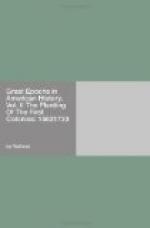But, to retumne a little more to the particulars of this Countrey, which I intermingle thus with my proiects and reasons, not being so sufficiently yet acquainted in those parts, to write fully the estate of the Sea, the Ayre, the Land, the Fruites, the Rocks, the People, the Gouernment, Religions, Territories, and Limitations, Friends, and Foes: but, as I gathered from the niggardly relations in a broken language to my vnderstanding, during the time I ranged those Countries &c. The most Northern part I was at, was the Bay of Penobscot, which is East and West, North and South, more than ten leagues; but such were my occasions, I was constrained to be satisfied of them I found in the Bay, that the Riuer ranne farre vp into the Land, and was well inhabited with many people, but they were from their habitations, either fishing among the Iles, or hunting the Lakes and Woods, for Deer and Beuers. The Bay is full of great Ilands, of one, two, six, eight, or ten miles in length, which diuides it into many faire and excellent good harbours. On the East of it, are the Tarrantines, their mortall enemies, where inhabit the French, as they report that line with those people, as one nation or family. And Northwest of Pennobscot is Mecaddacut, at the foot of a high mountaine, a kinde of fortresse against the Tarrantines adioyning to the high mountaines of Pennobscot, against whose feet doth beat the Sea.
But ouer all the Land, Iles, or other impediments, you may well see them sixteene or eighteene leagues from their situation. Segocket is the next; then Nufconcus, Pemmaquid, and Sagadahock. Vp this Riuer where was the Westerne plantation are Aumuckcawgen, Kinnebeck, and diuers others, where there is planted some corne fields. Along this Riuer 40 or 50 miles, I saw nothing but great high cliffes of barren Rocks, ouergrowne with wood: but where the Saluages dwelt there the ground is exceeding fat & fertill. Westward of this Riuer, is the Countrey of Aucocisco, in the bottome of a large deepe Bay, full of runny great Iles, which diuides it into many good harbours. Sowocotuck is the next, in the edge of a large sandy Bay, which bath many Rocks and Iles, but few good harbours, but for Barks, I yet know. But all this Coast to Pennobscot, and as farre I could see Eastward of it is nothing but such high craggy Cliffy Rocks & stony Iles that I wondered such great trees could growe vpon so hard foundations. It is a Countrie rather to affright, then delight one. And how to describe a more plaine spectacle of desolation or more barren I knowe not. Yet the Sea there is the strangest fish-pond I euer saw; and those barren Iles so furnished with good woods, springs, fruits, fish, and foule, that it makes mee thinke though the Coast be rockie, and thus affrightable; the Values, Plaines, and interior parts, may well (notwithstanding) be verie fertile.




